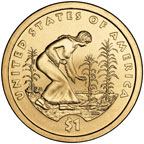Coin of the Month
Uncovering America's Heritage... Coin by Coin
2009 Native American $1 Coin
The coin I picked for June is the 2009 Native American $1 Coin. The design on the back shows a Native American woman sowing seed in a garden where corn, beans, and squash are growing.
Growing these three crops together is known as "Three Sisters" agriculture, or what scientists call "companion planting." In this system, the crops are planted in hills instead of in separate rows so they can work together. But where did this system come from? Did the American Indians learn it from the European colonists?
Actually, archaeologists have found evidence of farming in North America as long as 7,000 years ago. So the Americas' native nations were farming long before Europeans even knew the Americas were here. What's more, vegetables like corn, tomatoes, and potatoes were unknown in Europe. It took these savvy native farmers to tame the wild native plants, creating crops that would eventually be served around the world.
What's more, Native American crops in the early colonies were so bountiful that there was enough left over to supply the colonists, who knew little about cultivating the foreign soil of the New World. Colonies were saved and settlers kept from starvation on more than one occasion thanks to Native American agriculture.
Since this coin series aims to honor the ways in which Native Americans helped the nation to grow, agriculture is a great topic for the first coin in the series. You can read more about this coin design on the Native American $1 Coin page.
—Bill


Content Related Link


